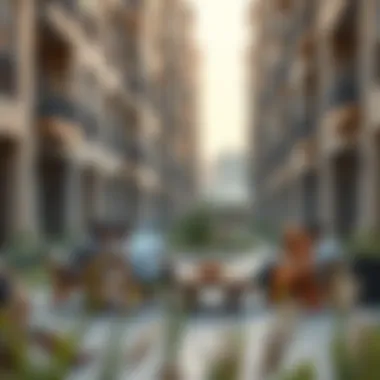Zayed Housing Program's Impact on Dubai Real Estate


Intro
In the glitzy realm of Dubai's real estate market, the Zayed Housing Program stands out as a beacon of support, shaping the urban landscape in ways both profound and practical. Established to fulfill the needs of its citizens, this initiative does more than just provide housing — it reflects the broader aspirations of a society striving for balance between modernity and cultural identity. As the city burgeons with diverse developments, one could say that this program is akin to the heart of a well-functioning ecosystem, pumping vitality into neighborhoods while fostering sustainable growth.
Understanding the nuances of the Zayed Housing Program is vital for various stakeholders — be it investors looking for promising avenues, expatriates seeking residence, or analysts examining urban trends. Throughout this article, we'll sift through the historical development of the program, trace its influence on market dynamics, and gauge the future trajectory of this ambitious initiative.
In a city where skyscrapers meet the sun, the housing program is not merely a footnote; it’s a pivotal player in crafting what it means to live and thrive in Dubai. We’ll explore how the program interplays with current market trends, investment opportunities, and the community's evolution, creating layers of insight for those invested in understanding this dynamic landscape.
Market Trends
Current Property Prices
Property prices in Dubai have seen significant swings over recent years. The Zayed Housing Program contributes to creating stable housing prices by steering development towards underutilized areas, thus invigorating local economies while cooling rampant inflation in prime districts. Currently, the prices average around AED 1.5 million for a standard villa, but speculations point towards a rise due to increased demand from both locals and expatriates drawn by the enhanced infrastructure.
Future Forecasts
Looking ahead, experts predict a steady climb in property values, especially in areas benefiting from government investments. The Zayed Housing Program fuels growth not only through direct housing projects but also by enhancing necessary infrastructure, such as schools and healthcare facilities around new developments. As urbanization continues, we might witness a sustained increase of 5-7% in housing prices across various sectors by the end of the next five years.
Investment Opportunities
High-ROI Areas
Identifying high-return-on-investment regions is crucial for savvy investors. Neighborhoods like Al Furjan and Dubai South are emerging as hotspots, largely due to the direct support from the Zayed Housing Program. These areas benefit from strategic planning and increased amenities, making them attractive for long-term investment.
Among the promising spots,:
- Dubai Hills Estate: Offers a blend of luxury and practicality, ideal for families.
- Dubai Marina: A classic choice with consistent rental demand, appealing particularly to expatriates.
Financing Options
Navigating the financing landscape can be tricky. Fortunately, the Zayed Housing Program offers various avenues for citizens, including:
- Subsidized loans: To alleviate the financial burden on homebuyers.
- Flexible payment plans: Tailoring options based on income levels and family size, ensuring accessibility for all.
"A well-planned housing program can determine the success of urban development, crafting not just structures but communities."
For more detailed insights, you can read about Dubai’s urban planning initiatives on Wikipedia or explore discussions on Reddit.
This exploration lays the groundwork for understanding the intersecting roles of community welfare and real estate, setting the stage for future discourse.
Prologue to Zayed Housing Program
The Zayed Housing Program is a cornerstone in addressing the ever-evolving housing needs of residents in Dubai, particularly for Emirati citizens. It acts as a fundamental player in the broader context of the city's real estate landscape. This program not only bolsters homeownership rates but also stimulates economic growth through infrastructure development, thereby cementing its relevance in contemporary discussions surrounding urban living.
Historical Context
To appreciate the current role of the Zayed Housing Program, one must first understand its historical backdrop. Established in the early 1990s, the program was a response to a pressing demand for affordable housing in the UAE. It emerged at a time when rapid urbanization and a significant influx of people into Dubai posed challenges for housing availability. The initiative aimed to provide Emirati families with access to quality homes, reflective of their cultural values and societal needs.
This endeavor was inspired by Sheikh Zayed bin Sultan Al Nahyan’s vision for a stable, prosperous society. His relentless pursuit of improving the quality of life for citizens set the stage for the program's inception. Over the decades, the Zayed Housing Program has evolved, adapting to advancements in construction technology and shifts in urban planning strategies. Nowadays, it's more than just a housing initiative; it's a framework that lays the groundwork for sustainable urban communities.
Core Objectives
The core objectives of the Zayed Housing Program revolve around several key pillars:
- Enhancing Homeownership Rates: At its heart, the program seeks to boost homeownership among Emiratis, recognizing it as a pathway to stability and prosperity.
- Fostering Sustainable Communities: By considering environmental factors in housing projects, the program promotes sustainable living practices across new developments.
- Supporting Economic Growth: Improved housing is seen as a catalyst for broader economic activity, catalyzing job creation in construction, real estate, and related sectors.
- Promoting Social Cohesion: The program aims to strengthen communal bonds by developing neighborhoods that encourage social interaction and cultural continuity.
"The Zayed Housing Program symbolizes not only homes but a commitment to the welfare of the UAE’s citizens. It’s about building a legacy that endures through generations."
These objectives are designed with the intent of creating a holistic housing strategy that serves not just as shelter, but as a foundation for nurturing family life, community ties, and economic prosperity. In this manner, the Zayed Housing Program plays an integral role in shaping the future of housing in Dubai, laying the groundwork for a progressive society.
Framework of the Zayed Housing Program
The framework of the Zayed Housing Program is a critical element that defines how housing solutions are provided within Dubai's expanding real estate market. This program is not merely about constructing buildings; it aims to create holistic communities that meet the diverse needs of Dubai's residents. The various components of this framework are designed to be in sync with contemporary housing demands and urban planning initiatives, making it an essential focus for investors, agents, and prospective homeowners alike.
Eligibility Criteria
When it comes to eligibility, the Zayed Housing Program adopts a systematic approach to ensure fair access to housing. Primarily, the program focuses on Emirati nationals who need assistance in securing a home. Factors that play a pivotal role in determining eligibility include:
- Age: Applicants generally must be of a certain minimum age, usually 21 years or older.
- Income Level: The program supports those who qualify based on income thresholds, aiming to assist low to moderate-income families.
- Family Status: Priority is often given to those with larger families or dependents, reflecting the program’s commitment to fostering family-oriented living environments.
- Current Housing Situation: Individuals or families currently living in inadequate housing conditions may receive preference.


The importance of these criteria lies in their ability to pave the way for the right applicants to access affordable housing solutions, which in turn strengthens community bonds and enhances living standards across the Emirate.
Application Process
Navigating the application process for the Zayed Housing Program can seem daunting at first glance, but the program is largely designed to be user-friendly. Here's a rundown of the essentials involved:
- Gathering Required Documentation: Applicants need to collect a series of documents, which might include:
- Online Submission: An online platform is available for applicants to submit their completed applications. This digital approach not only streamlines the process but allows for faster processing times, which is a significant advantage for families in urgent need of housing.
- Assessment and Approval: After submission, applications are assessed based on predetermined criteria, with results typically communicated within a specified timeframe. The assessment focuses on eligibility elements like income and family size.
- Follow-up: Successful applicants may be required to participate in follow-up meetings or interviews to finalize housing solutions tailored to their needs.
- Copy of Emirates ID
- Proof of income
- Family book (in cases of Emirati families)
- Housing needs assessment from a reliable local authority
Overall, the application process represents a seamless transition into homeownership for many, reflecting both transparency and efficiency in a landscape where timely access to housing solutions is essential.
"The Zayed Housing Program embodies a vision for inclusive housing, aiming not only to provide shelter but also to enhance the quality of life for all Emiratis."
In summary, understanding the framework of the Zayed Housing Program, along with its eligibility criteria and application process, provides valuable insights into how this initiative influences Dubai's real estate landscape. For investors and stakeholders, recognizing these elements is key, as they reveal ongoing opportunities to participate in a program that turns the dream of homeownership into reality.
Funding and Resources
The role of funding and resources in the Zayed Housing Program cannot be understated. It stands as the backbone that supports both the infrastructure and implementation of this crucial housing initiative. As the program strives to meet the growing demand for housing among Emiratis, having a robust financial framework is vital. The funding model not only encourages construction but also drives innovation and sustainability within Dubai’s real estate scope. In essence, the availability of funds directly correlates with the program's ability to deliver housing solutions
Government Contributions
Government contributions are pivotal in enhancing the Zayed Housing Program’s capabilities. These contributions are not only financial but also encompass policy support and regulatory frameworks that empower the program to function effectively. The Dubai government has allocated vast resources aimed at reducing the financial burdens of homeownership for citizens. This includes subsidized loans, low-interest rates, and minimal down payments. Such initiatives have been fundamental in addressing some pressing challenges, like affordability.
- Subsidized Loans: Providing loans to eligible citizens at significantly reduced interest rates.
- Infrastructure Investments: Funds are also directed towards building necessary infrastructure like roads, schools, and hospitals that support the housing developments.
In addition, the government seeks to bridge the gap between private sector contributions and public requirements through extensive collaboration. By curating partnerships with various financial institutions, it has been able to pool funds that ultimately enhance the program's reach and effectiveness.
Private Sector Involvement
The role of the private sector in supporting the Zayed Housing Program is becoming increasingly evident. With the government steering the program through initial funding stages, private companies have been encouraged to step in and provide additional resources.
- Investment Opportunities: Real estate developers are being encouraged to invest in projects aligned with the Zayed Housing Program. This involvement leads to a variety of housing projects being launched, expanding the market for newly built homes.
- Innovation and Expertise: Private entities bring their expertise in construction efficiency, sustainable building practices, and design innovations to the table. These contributions not only help in delivering housing more efficiently but also ensure that the housing stock remains relevant and appealing in modern Dubai.
The symbiosis between public funding and private investment has created an ecosystem where resources are shared, ensuring that the Zayed Housing Program not only meets present demands but is also adaptable to future challenges.
"Combining governmental foresight and private capital, the Zayed Housing Program sets the stage for a robust housing landscape in Dubai, fostering both growth and sustainability."
In summary, the intricate dance between government and private sector funding creates a comprehensive approach to housing solutions that addresses both immediate housing needs and long-term urban development goals.
Impact on Dubai's Housing Market
The impact of the Zayed Housing Program on Dubai's housing market is both profound and multifaceted. As the emirate continues to grow at an unprecedented pace, the demand for affordable housing becomes increasingly pressing. The Zayed Housing Program plays a pivotal role in addressing this demand, reshaping the housing landscape, and promoting sustainable urban development in the city.
Increasing Homeownership Rates
One of the most notable features of the Zayed Housing Program is its significant contribution to increasing homeownership rates among Emirati citizens. Homeownership is often seen as a cornerstone of financial security and social stability. Under this program, eligible applicants can access various housing solutions that facilitate the transition from renting to owning a home.
The provision of subsidized loans, grants, and low-interest financing enables families to purchase houses that meet their needs and aspirations, fostering a sense of belonging and community. In recent years, the homeownership rate has surged due to the program's initiatives, bringing many families into the realm of property ownership.
- Key Benefits:
- Enhanced financial stability for families.
- Increased investment in the local economy through real estate.
- Strengthening of community ties as families settle in their own homes.
"Homeownership rates have skyrocketed, making what once seemed like a distant dream a reality for many families in Dubai."
Influence on Real Estate Dynamics
The Zayed Housing Program is altering not only who owns homes in Dubai but also how the overall real estate market functions. Housing supply is being strategically aligned with demand, ensuring that the properties available meet the needs of the populace. This aspect has led to a more balanced market where buyers have viable options across various segments, from affordable housing to mid-range properties.
Moreover, with more residents becoming homeowners, the dynamics of supply and demand are shifting. A robust homeownership base often leads to increased consumer confidence. This momentum can spur new developments and expansions of existing communities.
Additionally, the program encourages developers to engage with the government more actively. They are often compelled to align their projects with the interests of the Zayed Housing Program, creating incentives for better-quality construction and sustainable practices. This means not only is housing becoming more accessible, but it is also evolving to meet modern standards of living.
- Key Influences:
- Developers adapt to new market demands.
- Improved property value stability in urban areas.
- Increased investment opportunities for both local and global investors.
In summary, the Zayed Housing Program is a cornerstone in Dubai's housing strategy. It bolsters homeownership, transforms market dynamics, and lays the groundwork for sustainable development. As Dubai continues to evolve, the program's influence will likely drive further innovations in the housing sector.


Urban Development Initiatives
The Zayed Housing Program significantly influences Dubai's urban fabric and its forward momentum. Urban development initiatives concentrate primarily on the features that ensure the city not only grows in size but also enhances livability for its residents. The symbiotic relationship between residential projects and holistic urban planning not only yields aesthetically pleasing environments but also occurs through infrastructural benefits that foster connectivity and accessibility.
Integration with Urban Planning
Integration with urban planning is crucial in ensuring that the housing developments provided through the Zayed Housing Program are well-aligned with Dubai’s overarching vision. Such an alignment guarantees that residential projects meet the needs of current and future populations while also contributing to the sustainable development of the city.
Initiatives are undertaken to map out residential areas that are equipped with surrounding amenities such as schools, hospitals, and recreational spaces. The program often collaborates with local authorities to devise comprehensive master plans that take not just individual housing needs into account but also promote community growth. The end goal is to create harmonious neighborhoods that not only serve housing needs but also encourage social interaction, creating vibrant communities.
Key considerations include:
- Density Management: Ensuring that residential areas do not become overcrowded while maximizing land use efficiently.
- Public Transport Accessibility: Facilitating ease of movement for residents, so they are not reliant solely on personal vehicles.
- Infrastructure Support: Coordinating the construction of roads, utilities, and community facilities that support new housing developments.
Sustainability Practices
Sustainability remains a cornerstone of any urban development initiative, and this is particularly true within the context of the Zayed Housing Program. The challenges posed by rapid urbanization necessitate practices that balance growth with ecological preservation. The program seeks to implement sustainability practices that contribute to the overall well-being of both inhabitants and the environment.
These practices include:
- Green Building Standards: Encouraging the use of sustainable materials and energy-efficient systems in housing construction.
- Waste Management Solutions: Promoting systems that reduce waste and emphasize recycling within communities.
- Water Conservation Measures: Implementing policies that advocate for water-efficient landscaping and plumbing within new housing developments.
"Urban sustainability is not just an option for the future; it is a necessity for the well-being of our cities today."
In adopting a comprehensive approach to sustainability, the Zayed Housing Program not only addresses housing demands but also sets a benchmark for future developments in the city. The emphasis on integrating modern eco-friendly techniques ensures the longevity and resilience of urban environments.
In summary, the Zayed Housing Program does not merely react to the growing demands of Dubai’s populace; it proactively engineers environments that bolster community ties and uphold sustainable living principles. Such urban development initiatives are essential components in stabilizing the city's real estate landscape for generations to come.
Challenges in Implementation
The Zayed Housing Program has undeniably marked a significant step forward in addressing housing needs in Dubai. However, like any ambitious initiative, it faces a multitude of challenges that must be navigated carefully. Understanding these challenges is crucial for all stakeholders involved—including government officials, investors and the residents who benefit from this program. Tackling these issues head-on is essential to ensure that the program fulfills its intended purpose and continues to adapt in a fast-paced real estate market.
Bureaucratic Hurdles
Navigating the labyrinth of bureaucracy is one of the major challenges facing the Zayed Housing Program. The application and approval process, while designed to maintain fairness, can be lengthy and complicated. Many applicants find themselves entangled in endless paperwork, often passing through multiple departments that require detailed documentation.
- Delayed Approvals: As a result, potential homeowners may experience significant delays, disrupting their plans for building or acquiring their homes. This bottleneck can deter applicants from seeking assistance, as waiting times can stretch over several months or even years.
- Inconsistent Policies: Furthermore, fluctuating policies and regulatory changes can lead to inconsistencies in how applications are processed. This unpredictability can leave applicants unsure of where they stand and whether they’ll meet the eligibility requirements.
This bureaucratic push-and-pull not only creates frustration among potential homeowners but also challenges program administrators, who must balance efficiency with thoroughness.
Public Perception Issues
Another critical aspect of the challenges is how the public perceives the Zayed Housing Program. While many view it as a beacon of hope for affordable housing, others harbor reservations. Public perception can be shaped by several factors:
- Awareness Levels: Many citizens simply might not be aware of the program's offerings or the nuances of eligibility. This lack of awareness can result in underutilization of available resources, leaving many deserving families out in the cold.
- Skepticism Towards Effectiveness: In some circles, skepticism about the program's efficacy can lead to negative press and diminished enthusiasm among investors. If the community does not believe the program is delivering on its promises, this sentiment can spread like wildfire, affecting everything from grassroots advocacy to investment inflow.
Addressing public perception challenges half-heartedly can dampen the program’s impact significantly. Ongoing community engagement, transparent communication, and success stories shared through local media channels must be priorities to build trust and foster a more positive image.
Key Insight: The success of the Zayed Housing Program hinges on its ability to overcome these bureaucratic challenges and changing public perceptions, ultimately ensuring its longevity and relevance in Dubai's evolving housing landscape.
Future Projections for Housing in Dubai
The future of housing in Dubai is a topic steeped in anticipation and speculation. The Zayed Housing Program stands as a pivotal factor shaping this landscape, illustrating how innovative policies can influence both the housing market and the community at large. Convenience in homebuying, alongside sustainable urban practices, will be crucial as the city grapples with rapid growth and increasing population density.
The core of future housing trajectories in Dubai revolves around the following elements:
- Urban Sustainability: With a focus on eco-friendly designs and green architecture, Dubai aims to minimize its ecological footprint. This is not just a trend but rather a necessary path forward, ensuring that urban sprawl does not come at the expense of the environment.
- Affordable Housing Solutions: The demand for affordable housing options continues to grow. Initiatives like the Zayed Housing Program provide essential support, indicating a shift towards a more inclusive housing market where every citizen has the opportunity to find a home.
- Technological Integration: As technology progresses, the architecture and construction sectors are experiencing a major shift. Innovative materials and smart home technology are poised to dominate future developments, making homes more efficient and appealing.
Predicted Market Trends
The housing market in Dubai is known for its dynamism. Analysts predict that several trends will dominate in the coming years:
- Rise in Demand for Eco-Conscious Homes: Buyers are increasingly seeking homes equipped with features that promote water and energy conservation, boosted no doubt by local regulations encouraging sustainable living.
- Focus on Mixed-Use Developments: The urban landscape will likely see an uptick in mixed-use spaces that combine residential, commercial, and recreational facilities, fostering thriving communities.
- Continued Influx of Expatriates: With Dubai being a melting pot of cultures, the expatriate population will continue to grow, translating into a stretched demand for housing, in turn pushing up prices and driving investment in new projects.
This sets the stage for potential gains in property values, but it calls for an equally strategic approach to urban planning and development to avoid oversupply risks.
Role of Technology in Housing
The role of technology in the housing sector is evolving at lightning speed and is expected to have far-reaching impacts:


- Smart Home Integration: Technology is not just about luxury; it’s a way to enhance livability. Homes equipped with smart devices that optimize energy consumption and improve security are anticipated to draw more buyers.
- PropTech Ventures: Property technology is altering how transactions occur, from virtual house tours to blockchain secure transactions, making these tools key for investors and buyers alike.
- Data-Driven Insights: Developers will increasingly rely on data analytics to guide project planning, ensuring they meet market demands more effectively and efficiently.
Investors should keep an eye on these tech-driven shifts, as they could significantly reshape how housing transactions are conducted and how value is derived from properties in Dubai.
"The only thing that is constant is change." "In the world of real estate, technological advancements are the catalysts driving that change."
In summary, as Dubai embraces its future in housing, the synergy between government initiatives like the Zayed Housing Program and technological advancements will likely create a vibrant and sustainable real estate environment.
Investment Opportunities Linked to the Program
The Zayed Housing Program represents a significant initiative within Dubai’s real estate scene, fueling various investment opportunities that appeal to a wide range of stakeholders. As Dubai continues to grow and evolve, the program becomes a beacon for those looking to engage in the housing market, offering both potential rewards and unique considerations. The nexus between government initiative and private sector involvement creates a fertile ground for investment, further underlining the program's importance within this dynamic landscape.
Attracting Global Investors
Dubai's reputation as a global trade hub has attracted professionals, businesses, and investors from all walks of life. The Zayed Housing Program, with its tailored initiatives, aims to draw in international investors keen on tapping into the UAE residential market. This influx is not just about capital; it’s about fostering a diverse community that aligns with the emirate’s aspirations for an inclusive, thriving economy.
*The strategic framework of the program enables:
- Tax Incentives: These include various exemptions for foreign buyers.
- Streamlined Processes: The application process is designed to be efficient, removing red tape that often challenges foreign investment.
- Infrastructural Development: Recognizing that a robust infrastructure supports property values, the program is intertwined with the city's growth initiatives.*
Global investors look for more than just the potential of high returns. Market stability, strong regulatory frameworks, and government backing provide a sense of security that is often missing in emerging markets. Additionally, with the rising demand for affordable housing options in Dubai, international investors are now viewing the Zayed Housing Program as a strategic avenue to enter the market at a relatively lower cost with promising returns.
Potential for High Returns
The investment landscape shaped by the Zayed Housing Program hints at substantial returns for early adopters and seasoned investors alike. By opening up residential opportunities to a broader demographic, from local citizens to expatriates, the program positions itself as a catalyst for future profits.
*Factors that enhance the potential for high returns include:
- Rising Homeownership Rates: As more individuals gain access to affordable housing, property appreciation is nearly inevitable.
- Urban Development: Surrounding areas flourish as new housing entails additional commercial and recreational spaces, raising the overall property value of the neighborhood.
- Government Support: The sustained involvement of the UAE government through incentives and policies facilitates investor confidence.*
Moreover, the upcoming projects linked with the Zayed Housing Program are poised to inject vitality into the market, spearing growth in both residential and commercial properties. Investors know that as demand increases, so does the value of their investments.
This interconnected approach creates a ripple effect where not only do investors benefit, but the community and city infrastructure do too, laying the groundwork for sustainable urban living.
Ultimately, while uncertainties exist as with any investment, the Zayed Housing Program establishes a foundation that is unlikely to falter in the long term, making it an attractive consideration for those eyeing the opportunities embedded within Dubai's vibrant real estate landscape.
Case Studies
Understanding the successes and challenges of the Zayed Housing Program can be most effectively illustrated through the lens of specific case studies. These real-world examples offer invaluable insights into the program's effectiveness, highlighting both triumphs and obstacles encountered in the implementation process. By delving into case studies, we gain a clearer understanding of how the Zayed Housing Program has been applied across different demographics, and what this means for the future of housing in Dubai.
Success Stories
Success stories are a crucial part of the narrative surrounding the Zayed Housing Program. They not only showcase what can be achieved but also inspire confidence in stakeholders and potential investors.
For instance, consider the community in Al Gharoud, where families from various backgrounds have benefited significantly from this initiative. Many residents here received subsidized housing options that allowed them to settle in an area that was previously beyond their financial reach. The emotional connection these families have developed with their homes is a testament to the program's success.
Another compelling example comes from the Emirates City development. This project has seen rapid growth as a result of the funding and support from the Zayed Housing Program. Families report an increase in their quality of life, attributing it to the security and stability that comes with home ownership. Investors have also noted a positive shift in property values in the vicinity, contributing further to the effectiveness of this housing model.
"The Zayed Housing Program has transformed not just individual families, but entire communities, setting a precedent for future development in the region."
Lessons Learned
While success stories paint a rosy picture, it is equally important to learn from setbacks encountered along the way. Lessons learned from these case studies give a broader perspective on areas needing improvement within the program.
A major lesson stems from the bureaucratic processes observed in the application and approval stages. For instance, some applicants in areas like Dubai Marina faced delays in receiving their housing assistance due to administrative backlogs. This highlights the need for a more streamlined process that can adequately handle the volume of applicants without compromising efficiency.
Moreover, public perception of the adequacy of housing solutions was also a point of concern in some regions. Feedback indicated that while the government's intent was commendable, there was often a mismatch between the housing provided and the needs of different demographic groups.
In summary, case studies reveal a rich tapestry of experiences that enrich the overall understanding of the Zayed Housing Program's impact on Dubai's real estate landscape. Both the success stories and the lessons learned illuminate the great potential this program holds while emphasizing the need for continuous improvement.
The End
The conclusion serves as the anchor point for understanding the comprehensive insights provided by this article regarding the Zayed Housing Program in Dubai's real estate scene. It ties together the multifaceted narrative that has unfolded throughout each section, emphasizing the profound importance of this program in addressing housing needs while simultaneously shaping the urban landscape of Dubai.
Summarizing Key Points
- Historical Significance: The Zayed Housing Program has roots deeply intertwined with the evolution of Dubai's demographics, reflecting on how the government has prioritized housing for its citizens amidst rapid urban growth.
- Core Objectives: Highlighting the program's objectives to promote homeownership and reduce the strain on rental markets has paved the way for an energized real estate sector.
- Funding Mechanisms: The collaborative model between government and private sectors showcases a solid framework, encouraging investments while appeasing diverse stakeholders.
- Impact on Homeownership: From increasing homeownership rates to enhancing real estate dynamics, the program elucidates how it nurtures socio-economic growth.
- Investment Avenues: With its protective measures for buyers and fiscal incentives for investors, the program creates lucrative opportunities for diverse stakeholders, enhancing market confidence.
Final Thoughts on Housing in Dubai
The challenges and projections surrounding the housing market in Dubai illustrate a landscape not only of growth but of adaptability. The Zayed Housing Program plays an integral role in this transition, fostering sustainable practices while addressing the nuances of urban sprawl. As global mega-cities navigate changes arising from technological advancements and environmental concerns, the lessons gained from this program can serve as a potential model for others.
In sum, the Zayed Housing Program is more than just a governmental initiative; it represents a visionary commitment to sustainable urban living that prioritizes the well-being of its residents. As discussions around urban housing evolve, it remains critical to evaluate how programs like these adapt and grow in response to both local and global shifts. By placing citizens at the heart of decision-making, Dubai not only enriches its urban tapestry but also reflects a broader commitment to inclusive growth and stability in its real estate landscape.
"The heart of a city is its people, and through initiatives like the Zayed Housing Program, we are weaving a future that is rich in community spirit and belonging."
For further insights, consider visiting Dubai Land Department or exploring research at Institute for Housing Studies.

